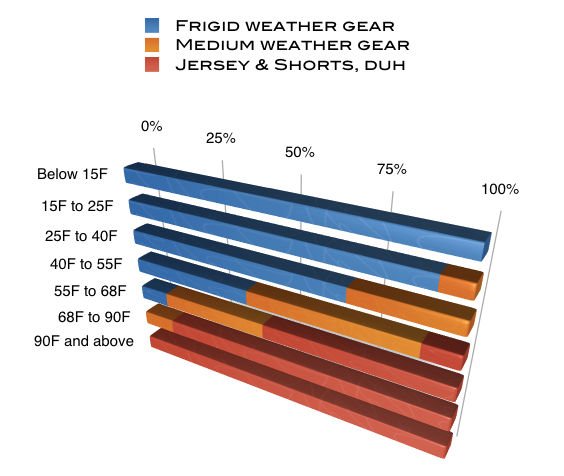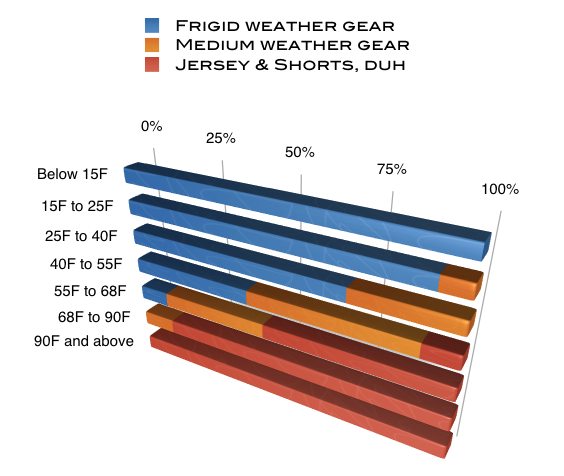°F = (°C x 9/5) + 32
I am freshly back from logging two weeks in the Belgian arctic, where spring has not yet sprung and Flanders is still wallowing in her natural frigid climes. While I was amid the thousands of cyclists, fans, and journalists begrudging the sub-zero temperatures, we mustn't forget that this is the northern hemisphere in the very tail end of winter and first week of spring. Prior to 2013 we'd been blessed with at least three years of reasonably warm weather during the Belgian Spring Classics week(s), so the fact that it was blustery and chilly this time around should not actually come as a surprise.And with that having been said, I wouldn't be a cyclist worth my salt if I didn't talk about the weather. It seems anyone upwards of a pack-fodder category 2 racer can speak with at least some degree of proficiency about the meteorological trends of his or her geographical area. Reading a Doppler radar map and knowing what a forecasted 45% chance of precipitation really means is their M.O.Most teams stick around the cobbled and blustery northern European front this week between Flanders and Roubaix, but we at Cannondale Pro Cycling are given the chance to press and hold the reset button and therefore briefly head home. It's an opportune way to clear one's mind, find some semblance of normalcy in life, catch up on missed internet, eat a non-hotel meal, get a few days of proper training in rather than the all too typical-canal-lap-and-coffee-shop-stop, and overall just rest up before bone jarring Paris-Roubaix on Sunday. Reconnaissance be damned(!), I'm perfectly happy sleeping in my own bed.Embracing these few days of freedom, I did this ride yesterday, which much like Belgium was also horrifically windy, but extremely soul cleansing.After having nary any skin exposed for the past, ooh, three months and having been particularly bundled up these past two weeks, I set out with both arm and leg warmers yesterday, but soon after removed them and boldly exposed my arms and legs throughout the day - if nothing else to absorb some succulent solar vitamin D. According to the SRM, the average temperature was 15C with a high of 18C, which is about 59 average and a high of 65 for you Fahrenheit fans. Brisk, but relatively balmy and warm. Worth noting for subsequent analysis, I also had a t-shirt length undershirt, thin wool gloves, a thin vest, and a cycling cap.With a Strava ride title such as it is regarding clothing choice, waking up today I was heartily entertained by the detailed dialogue going on in the comments section of that ride pertaining to said clothing choice. The talk of what to wear, when to wear it, where one's from, what are one's standards for weather conditions, and blah blah blah, the comments section of this ride became a forum for cycling clothing nerdery. And therefore needs my input.My first piece of advice is that it's all relative. There I was at four in the afternoon, four and a half hours into my five hour day wearing a mere jersey (and aforementioned vest and cap) and shorts when I rode by a friend and cycling colleague. He was five hours into his ride with an hour to go clad in everything I would typically be wearing this past week in Belgium. That is, leg-warmers, a thermal jacket, gloves, and shoe covers. He's a hearty Canadian and therefore knows cold weather. This is an example of PRO behavior and is certainly acceptable, but harkens back to traditional cyclists' thinking that if you're cold, you're going to get sick. To which I say Boo!There's this and this and this and a litany of other results upon searching, "can you get sick by being cold" that scream no. Which is not to say that it is a bad idea to stay warm on rides. Heck, I hate being cold. But to each his (or her) own. Moreover, everyone has an internal furnace and thermostat, so to tell someone that they're under-dressed or overdressed when whatever it is they're wearing fits into the realm of mildly reasonable clothing is quite frankly uniformed and naive.I digress. So what is "correct"? Per the above paragraph, there's clearly a range of acceptable. And per the paragraph where I had an encounter with my Canadian cycling brethren, there's a wide range of acceptable clothing options.After the rave reviews of my last homemade chart, let's create another one. Although this one will be more congruent and easier to read plus color coordinated, since we all know that red means hot and blue means cold... and apparently yellowy-orange means something in the middle. This chart breaks down what percentage of your current riding attire should consist of each of the following clothing types - Frigid, Medium, and just plain Jersey & Shorts - based on the temperature which is found in the Y-axis. This is pure science so pay attention. Frigid Weather Gear means as much Gore-Tex, windproof, and thermal clothing as you can afford. Oh, your big bad self is sponsored and therefore can "afford" everything? Super. Put it all on cause it's cold out. The rubbery'est of thick, rubbery shoe-covers are a must, mittens are mandatory over gloves, and a balaclava face mask is highly recommended. Undershirts should resemble long-underwear as if you're going skiing or ice climbing; that is, thick and long sleeve. Function over fashion here; you'll likely look like a bloated oaf with all this gear, but it's better than hypothermia and losing a few digits to frostbite.Medium Weather Gear means it's time to sub out your thermal/windproof/water resistant tights from above for mere bib shorts and leg-warmers. Conveniently you may now stow away your thermal jacket when arm-warmers and a jersey will do. Alternatively long-sleeved jerseys are a superb item. Vests fit snugly into this category, both the ambiguously titled "wind" vests and the much sturdier thermal vest. I don't use the word gilet because I think it's dumb. Furthermore, if you use the word gilet, then you likely fit into the category of person who might wear this sort of gilet. In which case... I'm very sorry. Undershirts consist of all sleeve lengths depending on your preference: long, t-shirt, or sleeveless. Hand garments are still generally long fingered, but considerably thinner than Frigid Gear. Furthermore, mittens are not in this category. Shoe covers are frequently over-socks. Stylish and functional although not so much when it's raining out. Wearing time trial specific shoe covers is generally pretty lame, unless you have a shoe sponsor conflict and you're therefore covering up your own errors. Then I'll let it slide. An iamnotTedKing neckgaiter is arguably the most functional item in this category and cycling caps are pretty darn handy too.Jersey & Shorts means just that. Short fingered gloves are acceptable if you are racing, motorpacing, or if you have sketchy bike handling skills and might crash yourself in training and you value your hands. But otherwise, please consider going sans gloves. I met a kid once who told me that he always wore a cycling cap because that that was his thing. It was about 99 degrees outside and you couldn't stand in the sun without breaking into a ferocious sweat. But he was my competition at the time and if overheating and sweating unnecessarily is his thing, then his detriment is my benefit and I let him go on his merry way.You will notice that there is no category above titled Just Bibs. Even when it's stiflingly hot out and you want to work off your farmer's tan you should never ride without a jersey. Rules are rules, my friends. Furthermore I don't care if it's your thing.So that's a wrap for today. Stay warm, stay cool, stay well dressed, and have a super day.
Frigid Weather Gear means as much Gore-Tex, windproof, and thermal clothing as you can afford. Oh, your big bad self is sponsored and therefore can "afford" everything? Super. Put it all on cause it's cold out. The rubbery'est of thick, rubbery shoe-covers are a must, mittens are mandatory over gloves, and a balaclava face mask is highly recommended. Undershirts should resemble long-underwear as if you're going skiing or ice climbing; that is, thick and long sleeve. Function over fashion here; you'll likely look like a bloated oaf with all this gear, but it's better than hypothermia and losing a few digits to frostbite.Medium Weather Gear means it's time to sub out your thermal/windproof/water resistant tights from above for mere bib shorts and leg-warmers. Conveniently you may now stow away your thermal jacket when arm-warmers and a jersey will do. Alternatively long-sleeved jerseys are a superb item. Vests fit snugly into this category, both the ambiguously titled "wind" vests and the much sturdier thermal vest. I don't use the word gilet because I think it's dumb. Furthermore, if you use the word gilet, then you likely fit into the category of person who might wear this sort of gilet. In which case... I'm very sorry. Undershirts consist of all sleeve lengths depending on your preference: long, t-shirt, or sleeveless. Hand garments are still generally long fingered, but considerably thinner than Frigid Gear. Furthermore, mittens are not in this category. Shoe covers are frequently over-socks. Stylish and functional although not so much when it's raining out. Wearing time trial specific shoe covers is generally pretty lame, unless you have a shoe sponsor conflict and you're therefore covering up your own errors. Then I'll let it slide. An iamnotTedKing neckgaiter is arguably the most functional item in this category and cycling caps are pretty darn handy too.Jersey & Shorts means just that. Short fingered gloves are acceptable if you are racing, motorpacing, or if you have sketchy bike handling skills and might crash yourself in training and you value your hands. But otherwise, please consider going sans gloves. I met a kid once who told me that he always wore a cycling cap because that that was his thing. It was about 99 degrees outside and you couldn't stand in the sun without breaking into a ferocious sweat. But he was my competition at the time and if overheating and sweating unnecessarily is his thing, then his detriment is my benefit and I let him go on his merry way.You will notice that there is no category above titled Just Bibs. Even when it's stiflingly hot out and you want to work off your farmer's tan you should never ride without a jersey. Rules are rules, my friends. Furthermore I don't care if it's your thing.So that's a wrap for today. Stay warm, stay cool, stay well dressed, and have a super day.

